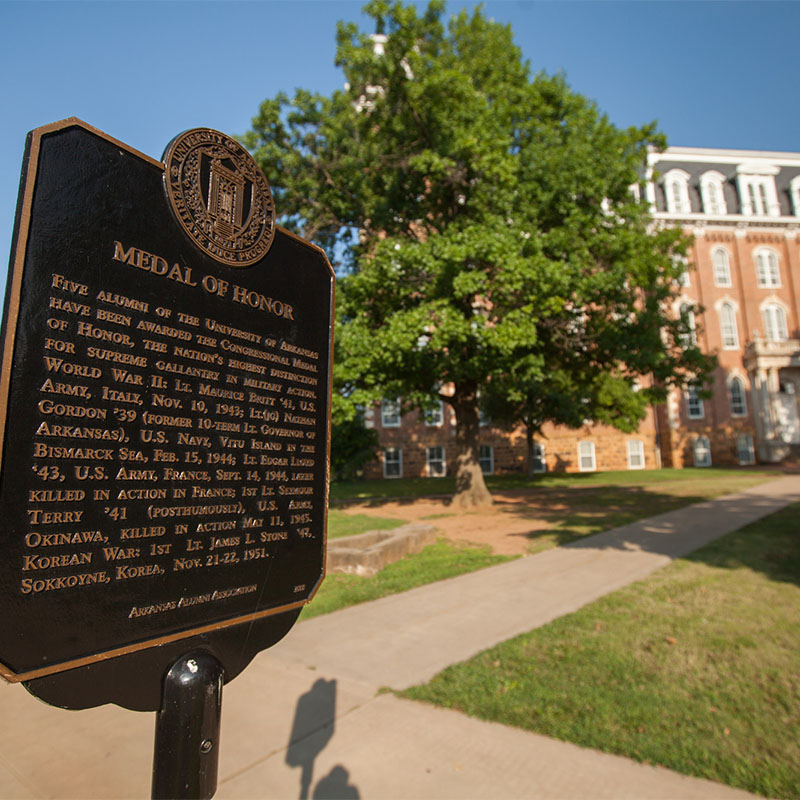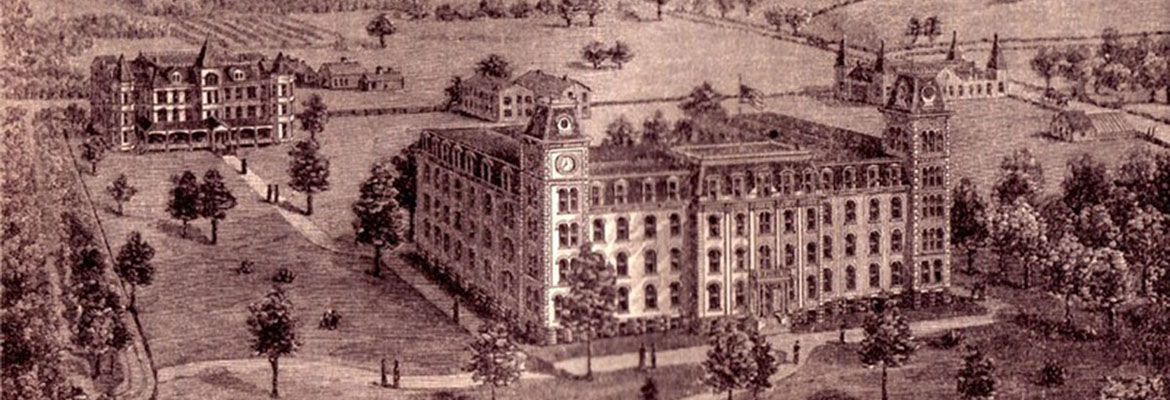
HISTORY OF THE UNIVERSITY OF ARKANSAS
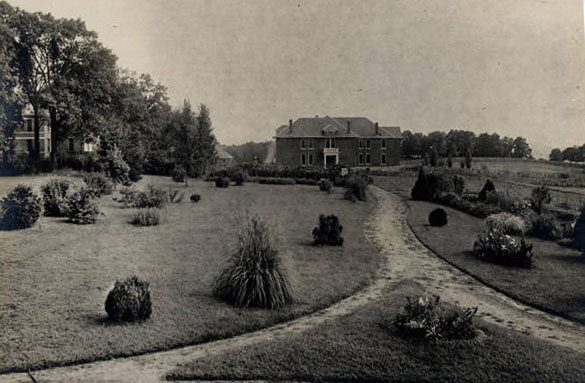
The 1871 establishment of the first public university in Arkansas — a state still ravaged and rankled by four years of civil war — might seem to us today to be an act more foolhardy than full of hope.
The founding of the university, however, was one of the few achievements during the state's Reconstruction era that brought former political and military rivals together.
Over the course of its history, the university has continued to bring the citizens of the state together by raising educational standards, improving business and economy, and giving Arkansans a hardy mascot around which to rally.
Read more about our rich history below and stop by our interactive timeline for a walk back through time.
Founding
The state legislature approved establishment of a land-grant university, to be known as the Arkansas Industrial University, on March 27, 1871. The federal Morrill Land Grant Act granted lands to Arkansas that could be sold, the revenues from which could then be used to pay for creation of the university.
The Board of Trustees set about determining a location, asking for cities and counties in the state to put forward bids for the university. Only two bids could be called serious, one by the town of Batesville and a second from Washington County, which offered $100,000 in bonds, and Fayetteville, which offered an additional $30,000 and 400 acres of land. This latter bid proved successful, and the board visited Washington County to determine a location, choosing the hilltop farm of William McIlroy as second to none.
The board purchased 160 acres from McIlroy and approved erection of a temporary frame building in which to hold classes while a permanent building could be planned. Classes began on January 22, 1872, with seven boys and one girl in attendance.
Over the course of the spring and summer, more and more students found their way to Fayetteville. Most of them lacked the preparatory coursework needed to pursue higher education, so the university provided both preparatory coursework and curriculum for a college degree.
More than 100 students attended the university that first year. Only three faculty taught initially, and Noah Putnam Gates served as the first president of the university.
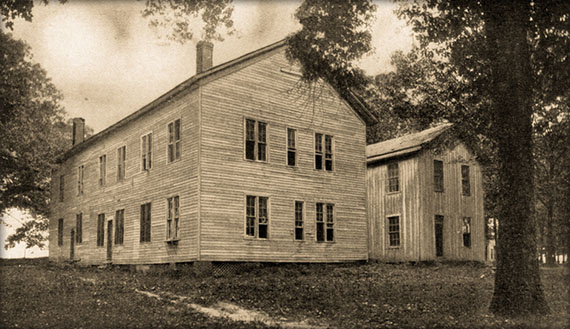
Did you know...
- Among the students that first year was the university's first African American student, James McGahee, who came from Woodruff County.
- During the first year, a student was wounded by a knife in an argument over a math problem. Today, we settle those disputes with proofs. Leave the knives at home.
- One student described the journey to the university that first year, riding the Little Rock and Fort Smith Railroad as far as the town of Ozark and then taking a stagecoach to Fayetteville along the route now known as the Pig Trail. On some steep hills, they had to get out and push the coach!
Building of Old Main
The Board of Trustees appointed a building committee to make plans for construction of a permanent building, a building that would, in essence, be the university.
After a visit to the University of Illinois to see its new main building, the committee sought out its architect, John Van Osdel, the premier architect of Chicago, to purchase plans for the same building at Arkansas. Van Osdel said his original plans had been destroyed in the great Chicago fire but that he would produce new drawings for $1,000.
Soon, a contract was let and construction begun on the building. Its design is known as Second Empire, with some Italianate touches. The most obvious design elements are the five blocks of the front — the middle entrance, two recessed walls and the two towers — and its mansard roof.
Nearly all of the construction materials came from Arkansas: the sandstone foundation, the bricks fired on the grounds, the limestone window sills and lintels, and wood milled from Ozark forests.
It was finished in 1875 and dedicated on a warm August evening with an all-day picnic spread upon the workbenches in the shadow of the south tower. As the day's light faded, lanterns and bricks soaked in oil were lit and fireworks fired.
It was and remains a building of aspiration, the largest in the state when completed with two towers reaching skyward. Today, those same towers serve as beacons to travelers from all entrances to Fayetteville and the building has become a symbol of higher education in Arkansas.
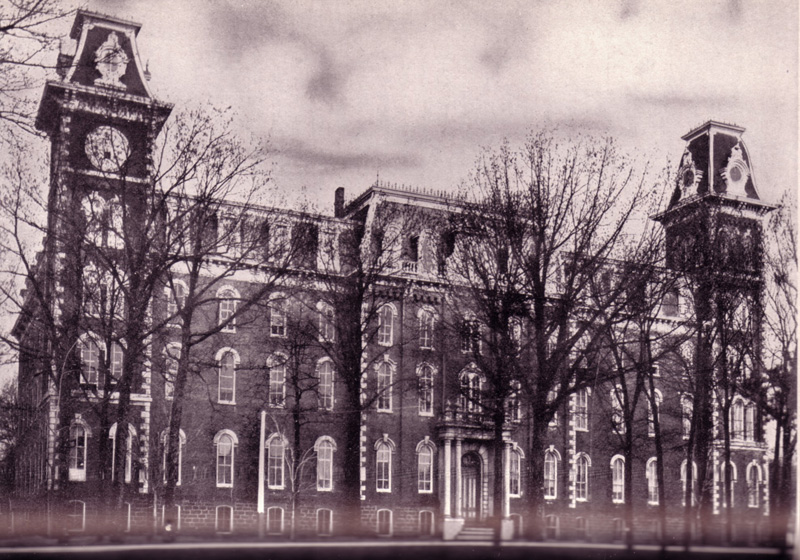
Did you know...
- The building at the University of Illinois upon which Old Main was based had its towers flip-flopped, giving rise to a myth that Union supporters switched the towers here so that the taller bell tower would be on the north side, a symbol of their victory.
- When built, Old Main had no electricity, no running water and — believe it or not — no Internet. It does now.
- So many of our academic programs at the university were first taught in Old Main that it is sometimes referred to as the "mother" of the university.
- In the 1980s, university officials considered razing Old Main. Instead, the campus and supporters from across the state raised money to renovate the building, and it reopened in 1991 for another century of service.
On the Hill
Over the first 50 years, the campus infrastructure grew slowly in a pattern that a regional planner might describe as pastoral growth. You and I might call it hodge-podge. New buildings were added at locations that seemed right for the new building but not necessarily as part of a strategic plan.
Keeping men on one side of campus and women on the other was about as strategic as it got in those early days.
The first men's residence hall, Buchanan Hall, was built west of Old Main. Meanwhile the first women's residence hall, Carnall Hall, named for Ella Howison Carnall, was built near the northeast corner of campus. Filling in the gaps were academic halls, some near Old Main, others farther off.
By the 1920s, however, leaders recognized the need to give the campus a more formal, collegiate look. An architectural firm in St. Louis, Jamieson & Spearl, developed a campus plan that called for demolition of every existing building, including Old Main, and development of a new set of buildings.
As it turned out, the university couldn't afford to remove buildings willy nilly, but it did set about creating a core of buildings designed and placed in accordance with the 1926 Campus Plan, including the Engineering Hall, the Chemistry Building, the Agriculture Building, the Home Economics Building, Memorial Hall and the crowning gem of the bunch, Vol Walker Hall, which was originally the university's library.
Today, the physical campus continues to grow at a rapid pace as we look toward the 21st century. Just since 2000, we've added, renovated or expanded more than 25 buildings, each designed with a strong sense of our historic fabric but also a nod to the future.
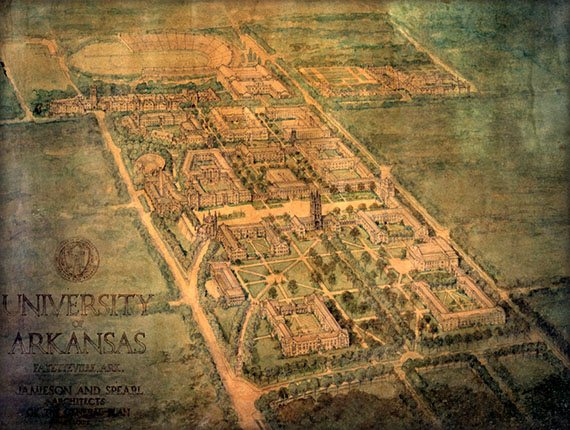
Did you know...
- Today, Vol Walker is home to the Fay Jones School of Architecture and Design. The building's historic structure and new modernist addition provide design students with a chance to see preservation and imagination in tandem.
- The Chi Omega Greek Theatre, a gift from the national sorority to celebrate its founding at the U of A, was inspired by the design of the open-air amphitheaters of classical Greece. It has served as a gathering place for pep rallies, commencements, weddings, concerts and the occasional screening of The Rocky Horror Picture Show.
- The 1926 Plan, though neglected during the latter 20th century, is once again used as a reference by campus planners, who try to create quads and fill in spaces in accord with the spirit of that plan.
- The core section of campus is a recognized historic district and many of the buildings are on the National Register of Historic Places.
- The Old Main Lawn — where students play touch football, throw Frisbees and occasionally get in a game of cricket — was initially used for growing oats, too.
Academic and Scholarly Growth
Although the university established a medical college at Little Rock during the late 19th century, its real growth in academic programs on the Fayetteville campus didn't occur until the early 20th century.
A college of agriculture was created in 1905. Soon after, university officials approved a broader restructuring to create the colleges of engineering, education, and arts and science.
All of these subjects had been taught from the beginning as part of the university's classical education, but growth in the student population and addition of faculty allowed deeper and broader investigation of these fields of study and the subsequent creation of colleges and schools.
By the mid-20th century, the university also added a college of business administration, a school of law and a nascent graduate school to develop programs leading to master's and doctoral degrees. Just after World War II, a program in architecture was created that led to establishment of a school of architecture.
Those colleges and schools are our primary degree-granting divisions of the university. But like a quilt overlaying them, three other academic divisions — a school of continuing education, the university libraries and an honors college — give support to each of the degree-granting divisions.
With the academic growth came a commitment to deeper research and scholarly activity. As the research grew, so did the draw of graduate students and federal grants from the National Science Foundation and more recently the National Institutes of Health.
In 2011, the Carnegie Foundation for the Advancement of Teaching added the University of Arkansas to its top level of research institutions, putting it among the top 2 percent based on the number of doctoral degrees granted, the annual research expenditures and our scholarly productivity.
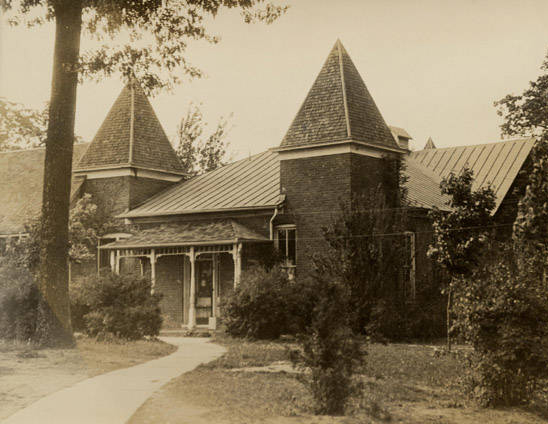
Did you know...
- Bill and Hillary Clinton started their careers as faculty members of the School of Law in the 1970s and were married in Fayetteville.
- The university’s program in creative writing has produced some of the top writers in the nation, including Ellen Gilchrist, a National Book Award winner, and C.D. Wright, whose Arkansas-inspired poetry earned her a MacArthur Fellowship, the so-called “Genius Grant.”
- • In 2003, the Walton Family Charitable Support Foundation gave $300 million to the university, the largest single gift to an American institution of higher education at the time. That gift has transformed the university, creating an Honors College and endowing the Graduate School.
Broadening Our Reach
The university's agricultural outreach began almost as soon as the gates of campus swung open during the 19th century. Over the next few decades, the college of agriculture and its extension network took research about crop, soil and agricultural pests to the farmers themselves in every county of the state.
We listened to hear their needs; they tried out our research to see what worked and what didn't. We learned from each other and found success together.
Building on that experience, in 1951 the University of Arkansas became the first land-grant institution in the nation to assemble an agricultural foreign mission, one to the nation of Panama. It's not as easy as driving down to Stuttgart to visit the state rice research center, but the international mission wasn't so different otherwise.
As with any cooperative venture, we learned as much about ourselves as did the Panamanians, and we have both reaped rich dividends in student exchanges, technology transfers and good, smart agricultural practices. A side benefit: The Arkansas Alumni Association established its first international alumni chapter in Panama in 2010.
In a similar vein as the agricultural outreach, legislation just after World War II sponsored by a U of A alumnus and then-U.S. senator, J. William Fulbright, created a program to support international exchange of scholars in 1949. Coming soon after World War II, the program was intended to help nations develop an understanding of one another and learn to live in peace. The University of Arkansas was among the first institutions to join in the exchange. Three students — Ingeborg von Groll of Germany and Roger Meindre and Peggy Heim, both of France — arrived in the September 1949 to live on campus and take coursework alongside U of A students.
The university also began sending students abroad as part of the exchanges. By 2013, more than 700 U of A students traveled abroad each year, and the campus hosted nearly double that number of international students, enriching both the lives of our visitors and the life of campus.
We continue in that spirit, welcoming droves of international students to our campus and sending our students into the world to study abroad. Both instances make us better global citizens, more aware of our cultural similarities and more understanding of our cultural differences.

Did you know...
- In nationwide competition among Pi Beta Phi members in 1913, Mary Droke of the University of Arkansas was awarded the Pi Phi Fellowship, a scholarly award that provided her one year of attendance at the University of Paris. Droke had finished a degree in music and was well on her way to finishing a mathematics degree.
- The university's first international alumni chapter was established in Panama in 2012.
- More than 700 students studied abroad in more than 40 countries this year.
The Sporting Life
Although students probably began competing in intramural contests early in the university’s history, the first intercollegiate games in football, tennis, baseball, and track and field, didn’t occur until about 1894.
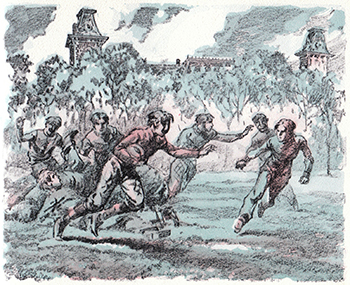 The early football games were played on the front lawn of Old Main, but were soon
moved to a level area approximately where the Fine Arts Center now stands, and the
university track was just to the north of it.
The early football games were played on the front lawn of Old Main, but were soon
moved to a level area approximately where the Fine Arts Center now stands, and the
university track was just to the north of it.
Originally known as the Cardinals because of the school color, the mascot was changed after the 1909 football season, when Arkansas went undefeated. Sportswriters and students had begun referring to the Arkansas team as the “razor-backs” as early as 1905, and Coach Hugo Bezdek popularized the name in 1909, reportedly saying after the LSU game that his team had “played like a wild band of razorbacks.”
Arkansas won its first national championship in 1964, when the football team went undefeated under coach Frank Broyles. Twenty years later, in 1984, the men’s cross country team won the university’s next national championship under coach John McDonnell. The team wasted no time waiting for another title, winning the indoor and outdoor track and field championships in the spring of 1985 to also become the first team in the nation to win the Triple Crown of track and field. The men’s track team now holds 41 national championships, the most recent added in 2013 under coach Chris Bucknam. In 1994, coach Nolan Richardson took his men’s basketball team to the national championship, defeating Duke University. And in 2015 and 2016, the women’s track and field team won its first national indoor and outdoor championships, respectively, under coach Lance Harter. Today, Arkansas is ranked sixth in the nation for total number of Division I national championships.
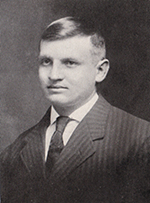 The University of Arkansas athletics program is one of the few in the United States
that operates within the revenue that it generates. Neither state taxes nor student
tuition is used to fund athletics, which instead is funded through gifts to the program,
ticket sales, licensing and broadcast contracts.
The University of Arkansas athletics program is one of the few in the United States
that operates within the revenue that it generates. Neither state taxes nor student
tuition is used to fund athletics, which instead is funded through gifts to the program,
ticket sales, licensing and broadcast contracts.
Today, the athletics department operates 19 teams: baseball, men's and women's basketball, men's and women's cross country, football, men's and women's golf, gymnastics, soccer, softball, swimming and diving, men's and women's tennis, men's and women's indoor and outdoor track and field, and volleyball.
Along with the NCAA athletics, though, the university has developed a deep program of club sports, intramural competition and recreational sports, including an outdoor recreation program more than 40 years old. From hockey and rugby to rock climbing and canoeing, the university offers an outdoor sport for every student. The university's Health, Physical Education and Recreation Building was paid for in part by students, who approved an additional fee to help pay for its construction. It remains a center of activity on campus.
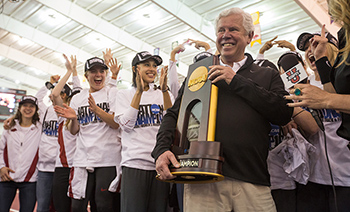
Did you know...
- The first U of A student to win an Olympic medal was Clyde Scott of Smackover. Scott won the silver medal in the 110-yard hurdles at the 1948 London Olympics. A few days later, two Arkansas alumni, Gordon Carpenter and Robert C. Pitts, won gold medals as team members of the U.S. men's basketball team. Since then alumni Joe Klein, Alvin Robertson, Michael Conley, Veronica Campbell, Omar McLeod and Taylor Ellis-Watson have also won gold medals.
- Coach John McDonnell coached more national championship teams than any other coach in any other sport in the country, a title he still holds in retirement. His cross country teams and indoor and outdoor track and field teams won 40 championships, including five Triple Crowns.
- When it opened in 1939, Donald W. Reynolds Razorback Stadium was originally called Bailey Stadium in honor of Gov. Carl Bailey. The name lasted only until the next election when a new governor had the name of his predecessor removed.
Our Student Body
Our university's emphasis is on student success. So it might seem contrary to leave the subject of students to be told at the end of this brief history of the university.
In history, though, recall that the end of the book is always the most recent development in history, the freshest moment, the newest big deal. In essence, for any university, that latest great thing will always be the new cadre of first-year students.
They show up each year for orientation, a little wide-eyed and bewildered, a bit frenetic and barely able to contain their energy, but also open minded and almost dreamy about the possibilities that the future holds.
In that sense, our students have not changed one whit over the last 145 years, save perhaps the fashions they wear.
But if they have not changed, our students themselves have changed the university in significant ways.
Students initiated the change of the university's name from Arkansas Industrial University to the University of Arkansas in 1899. Students chose the school colors in 1895. Students picked the Razorback as their mascot in 1910.
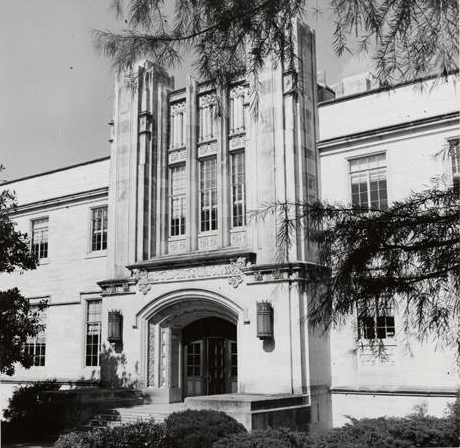 Our students campaigned for construction of the first student union, Memorial Hall,
and for development of the Health, Physical Education and Recreation Building, giving
their time, their creativity and their money to secure both buildings.
Our students campaigned for construction of the first student union, Memorial Hall,
and for development of the Health, Physical Education and Recreation Building, giving
their time, their creativity and their money to secure both buildings.
They wrote the university's first magazine in 1893, published the first yearbook in 1897, edited the first campus newspaper in 1906, broadcast the first student radio show in 1924 and the first television show in 1996. A student wrote the words to the Alma Mater and another wrote the Fight Song.
A student – Silas Hunt – was the driving force in integrating our university, peacefully and without litigation. His actions led others to seek enrollment at the segregated white colleges across the South and inspired the students who followed him here at the university to pursue integration of housing, diversity in the faculty ranks and equality on the athletic playing field.
Students are like the constantly roiling waters of an Ozark stream, slowly but surely cutting deep hollows into the mountains and changing forever the landscape of the Hill.
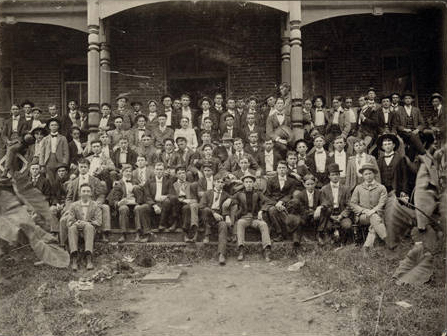
Did you know...
- Today, the University of Arkansas provides more than $180 million in financial assistance and scholarships each year. We are one of the few highly selective institutions to award both need-based and merit-based aid.
- Hank Hancock, a student from the Choctaw Nation, drew the first version of what we now call the "Running Razorback" in 1923. He drew it "full speed ahead."
- "Crip" Hall, a student during the 1920s, organized the first Homecoming, a time for alumni to return to campus and see what has changed.
- Five students have been awarded the Medal of Honor – Maurice Britt, Nathan Gordon, Edgar "Buck" Lloyd and Seymour Terry during World War II and James Stone during the Korean War.
Historical Markers
In April 1999, the University of Arkansas unveiled a set of institutional historical markers designed to commemorate significant research and intellectual achievements, notable leaders, outstanding alumni, historic events, sites and campus lore.
Subjects for commemoration in a historical marker were determined by the university's historical marker committee, chaired by the associate vice chancellor for university relations with representatives from the faculty and staff who were familiar with campus history.
The markers, designed by the office of university relations, are modeled loosely on roadside historical markers that are erected by many states, but the university's markers are tailored to pedestrians rather than autos. Made of bronze with gold lettering on a black background, the 17" x 24" plaques are affixed to poles at eye-level for easy reading. The markers were placed at sites appropriate to the subjects they are commemorating.
Uncover the many achievements of our University through the history detailed in the markers.
